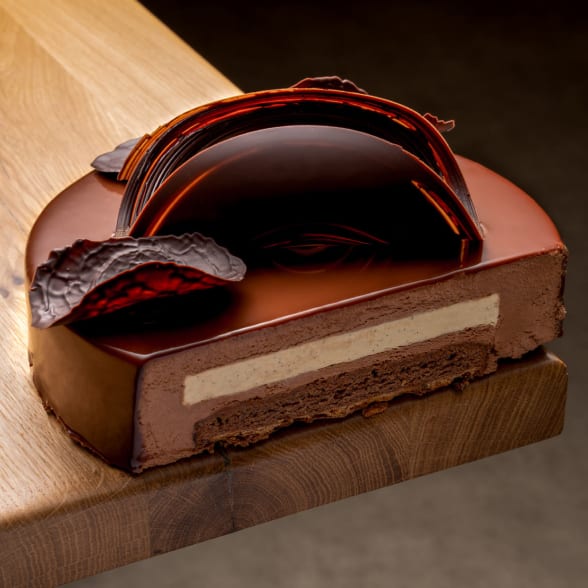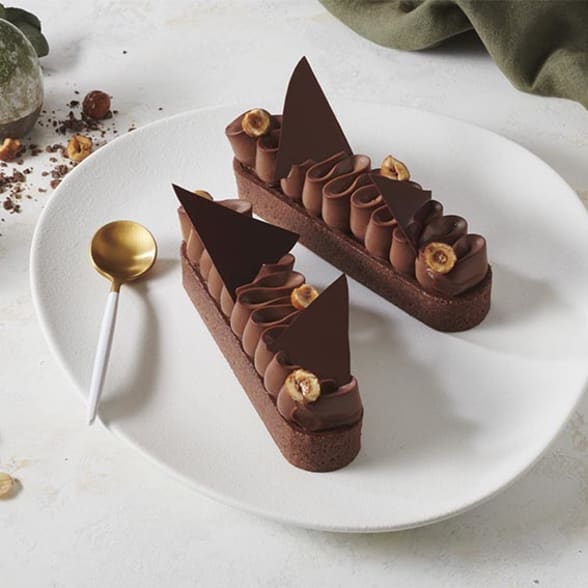
Professional Recipes
Our iconic creations will allow you to renew your offer by revisiting the great classics of pastry-making but also by offering you inspiring recipes to work with the raw material that is chocolate.
Contents :
Dark chocolate is eaten all over the world. This type of chocolate is particularly popular in France. But do you know exactly what dark chocolate is? Let’s take a closer look at this chocolate with an intense cocoa flavor.
Did you know? On average, dark chocolate accounts for 5% of European chocolate consumption. However, that figure rises to 30% in France! (Source: Kantar 2019)
Whether it is eaten as it is or used as a pastry ingredient, dark chocolate long delighted people of all ages. It differs from milk and white chocolate (or blond) in terms of its cocoa’s complexity and diversity.
It is the ingredients and their quantities that differentiate dark, white and milk chocolate. Cocoa is dark chocolate’s main ingredient. It is this that gives it all its power and subtlety.

Dark chocolate’s composition is regulated by law. To be described as a dark chocolate, a product needs to be at least 43% cocoa solids (including cocoa nibs and cocoa butter) sourced from the finest origins. At least 26% of these solids should be cocoa butter. You might not know that, before the 1980s, 43% dark chocolate was traditionally used for children’s snacks.
Dark couverture chocolate is ideal for professional pastry chefs and must contain at least 16% fat-free cocoa solids.
Many people still think that the higher a dark chocolate’s cocoa percentage, the better a chocolate will be. As we will see in a moment, this actually isn’t the case.
A high cocoa content does not always equate to quality in a dark chocolate. Take the example of wine: It is not the alcohol percentage but the terroir that lends a wine its qualities. The same principle applies to chocolate. It is not the quantity of cocoa but the quality of the beans, their terroir (origin, climate and plantation) and the chocolatier’s skills which shape its character.
In their cocoa library, Valrhona’s blending specialists ingeniously concoct original harmonies of great chocolates with inimitable flavors, much like the famous “noses” whose job is to create perfumes. Valrhona’s range of flavors includes Cuvées, Single Origin Grand Crus, Blended Grand Crus and other singularly exceptional chocolates.
Together, let’s take a closer look at what dark chocolate bars’ cocoa percentage means. This percentage indicates the proportion of the bar which is made up of cocoa.
This cocoa comes from both cocoa nibs (which are roasted and crushed cocoa beans) and cocoa butter (the vegetable fat from pressed cocoa beans), both of which are added to the chocolate recipe.
So a 70% dark chocolate bar is 70% cocoa (nibs and butter), with the remaining 30% mainly made up of sugar.
The balance between cocoa nibs and cocoa butter can vary and it isn’t reflected in the total cocoa content. Two chocolates with the same percentage might therefore have different amounts of nibs.
For example, the two chocolates below have the same cocoa percentage (70%), but not the same composition.

So what is the difference between these two 70% chocolates? As the cocoa butter is neutralized, only the cocoa nibs add flavor. Any differences are born out of the cocoa’s flavors and the character of its terroir, or by the quality of the chocolatier’s mixtures.
Whether you are a professional or a connoisseur, dark chocolate is available for you to use and enjoy in lots of ways. Dark chocolate is as useful for cooking as it is for simply eating as a quick snack.
Professional chocolatiers and pastry chefs can use dark couverture chocolate drops (or fèves, as they are known at Valrhona). This cocoa butter-enriched product is smoother, making all kinds of chocolate recipes possible, including bonbons, confectionery, ganaches and chocolate mousses.
Chocolate enthusiasts mainly eat dark chocolate in bar form. From Single Origin Grand Crus to exclusive blends, certified organic products and gourmet creations, at Valrhona you will find a wide variety of exceptional dark chocolate bars to enjoy and share endless with others!
You might not know that milk and dark chocolates provide about the same amount of energy (around 500 kcal per 100g). Milk chocolate is more sugary, but dark chocolate’s fat content is higher (because it is richer in beans and cocoa butter).
Dark chocolate is also the basis for lots of chocolate recipes. Valrhona’s exclusive range of chocolates for pastry-making and indulgent treats gives connoisseurs and exacting chocolate-lovers the chance to make pastries worthy of the most indulgent chefs.
The exceptional taste of Valrhona chocolates in your “homemade” pastries. If you want a delicious, creamy dessert, look no further than a chocolate melt-in-the-middle cake.
You can combine dark chocolate with all kinds of other flavors to bring out the best in your desserts and other creations. Here are some examples of ingredients that combine particularly well with dark chocolate to make pairings as delicious as they are unexpected!

Our iconic creations will allow you to renew your offer by revisiting the great classics of pastry-making but also by offering you inspiring recipes to work with the raw material that is chocolate.

Are you a pastry lover? Let yourself be tempted by Valrhona's chocolate creations. Our detailed iconic recipes will guide you step by step through the design of your chocolate pastry.
You are using an outdated browser. Please upgrade your browser to improve your experience and security.
×